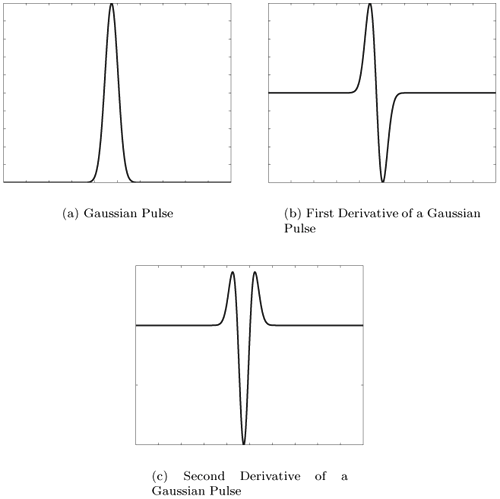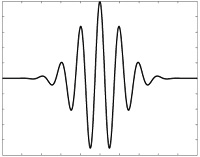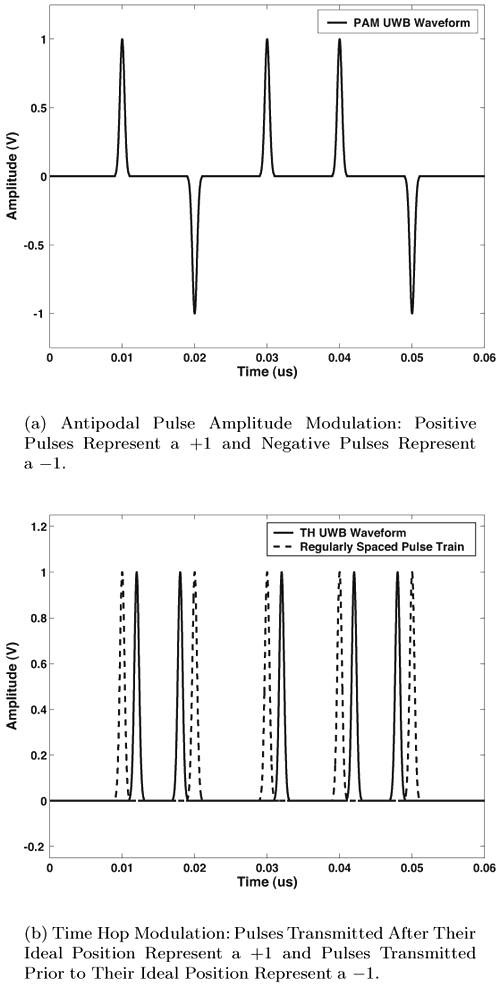Section 1.3. The I-UWB System Model
|
1.3. The I-UWB System Model1.3.1. Overview of the I-UWB SystemThis section presents the overall system model and notation convention that will be used throughout the book. The basic model for an unmodulated I-UWB pulse train was given in (1.1) and is repeated here Equation 1.3 Note that we have assumed that the pulse is not distorted by the channel. Thus, p(t) is the pulse that would be observed by the receiver in a distortionless and noiseless channel with infinite SNR. However, this is not necessarily equal to the pulse generated by the pulser circuitry, nor is it necessarily equal to the pulse launched by the transmitter. This is a unique feature of UWB systems and arises from the fact that the transmit and receive antennas can, and often do, distort the pulse shape. Thus, in our system model we assume that the antenna-induced distortion is included in the received pulse p(t). Recall also that the antenna-induced distortion can change with elevation and azimuth angles. Thus, we assume that such effects will ultimately be included in the assumed channel model. 1.3.2. Pulse ShapesBy far the most popular pulse shapes discussed in I-UWB communication literature are the Gaussian pulse and its derivatives, as they are easy to describe and work with. A Gaussian pulse is described analytically as Equation 1.4 where s is the standard deviation of the Gaussian pulse in seconds, and m is the location in time for the midpoint of the Gaussian pulse in seconds. Note that the pulse width, tp, is related to the standard deviation as tp = 2ps. An example is plotted in Figure 1.4(a). The first derivative of a Gaussian pulse is also a commonly used analytical pulse shape, due to the fact that a UWB antenna may differentiate the generated pulse (assumed to be Gaussian) with respect to time,[3] leading to the following pulse shape
Equation 1.5 where k is a constant that determines the pulse width, and we have assumed m = 0. A third model uses the second derivative of a Gaussian pulse or Figure 1.4. Example UWB Pulses. These three pulse types are plotted in Figure 1.4. The time axis is arbitrary and depends on the values assumed above for k and s. We should also note that the current FCC rules make UWB transmission most practical in the 3.110.6 GHz band. As a result, the preceding pulse shapes may not be useful for commercial systems. Instead, the Gaussian modulated sinusoidal pulse is more practical. Specifically, the pulse shape Equation 1.6 where fc is the desired center frequency for the pulse. An example plot of this pulse is given in Figure 1.5. Figure 1.5. Example of a Sinusoidal Gaussian Pulse. 1.3.3. Modulation SchemesI-UWB systems allow for several modulation schemes, including Pulse Position Modulation (PPM) and Pulse Amplitude Modulation (PAM).[4] A detailed discussion of modulation schemes will be presented in Chapter 5, "Transmitter Design." We introduce them here in order to establish the notation and system model used throughout this book. The transmit signal in the case of amplitude modulation is represented by
Equation 1.7 where Ai =di(t) now represents the amplitude of the ith pulse, which is dependent on the data di(t) and the specific modulation scheme. A pulse position modulation scheme is represented by Equation 1.8 where di(t) is the time modulation based on the information and d is the base time increment. As an example, let di(t) be anantipodal binary bit stream consisting of +1's and 1's. The transmitted PAM signal will consist of a stream of positive and negative pulses (Figure 1.6a). The transmitted PPM signal will consist of pulses that are shifted either slightly before or slightly after their ideal positions in a regularly spaced pulse train (Figure 1.6b). Figure 1.6. Example of Modulated UWB Signals Using the Data Sequence {1-1 1 1-1}. A key characteristic of UWB systems is their low power spectral density. The desire for low power spectral density (PSD) impacts the system model in two distinct ways. First, the pulse rate is often higher than the data rate. In other words, to obtain sufficient energy per symbol while maintaining sufficiently low PSD, multiple pulses will be associated with a single symbol. In this case the received signal is represented by Equation 1.9 where Ns is the number of pulses per symbol, and the symbol rate is Equation 1.10 The received signal is then modeled as Equation 1.11 where h(t) represents the channel that possibly distorts the transmit signal and is assumed to have unit average energy and represents the convolution operation. That is, we scale out all gross attenuation effects and include them in the noise power. The noise is assumed to be Additive White Gaussian Noise (AWGN) with power
Equation 1.12 where bi is the amplitude and sign of the ith path, ti is the relative delay of the ith path, d(t) is an impulse function, and Np is the number of paths. Note that in general we will model these parameters as random variables, as discussed in Chapter 3. 1.3.4. Multiple Access SchemesWhen a system has multiple users, we represent the transmit signal for user k as sk(t). The total received signal is given by Equation 1.13 where h(k) (t) is the channel impulse response between the kth user and the receiver, K is the total number of users considered, and n(t) is AWGN. In multiuser systems there are many forms of multiple access that will be discussed in Chapter 5. The signal model for TDMA-based (or random access methods) will not differ from that presented here. However, CDMA systems will require additional notation. When pseudorandom amplitude modulation is used to distinguish users, we represent the signal from the kth user as Equation 1.14 where Pseudorandom codes can also be applied to PPM schemes, and are often referred to as time hopping or pseudorandom dithering. In this case the transmit signal of the kth user is Equation 1.15 where the time hopping is accomplished with the sequence 1.3.5. Receiver Decision StatisticThe receiver estimates the most likely transmitted data symbol by using a decision statistic that is a function of the received signal Equation 1.16 where Z represents the output of the receiver, and the function f (Z) depends on the modulation scheme and receiver structure, as discussed in Chapter 6, "Receiver Design Principles," and Chapter 7, "On the Coexistence of UWB and Narrowband Radio Systems." Additionally, in diversity systems with multiple receiver branches (such as multiple antenna structures or a RAKE receiver) the decision statistic Z will be the sum of several statistics Equation 1.17 where L is the number of diversity branches, either in time or space, and zi is the statistic calculated per diversity branch. |
|
EAN: 2147483647
Pages: 110













